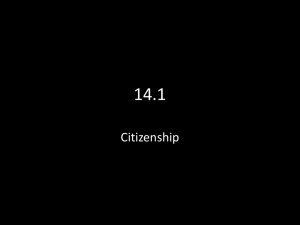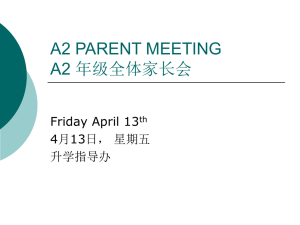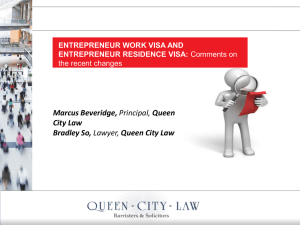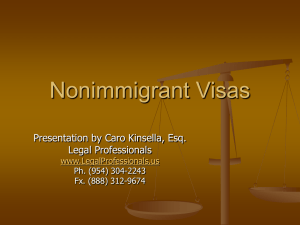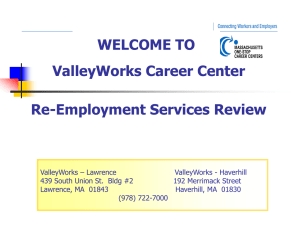The INA §214(b) Poltergeist at Entry
advertisement
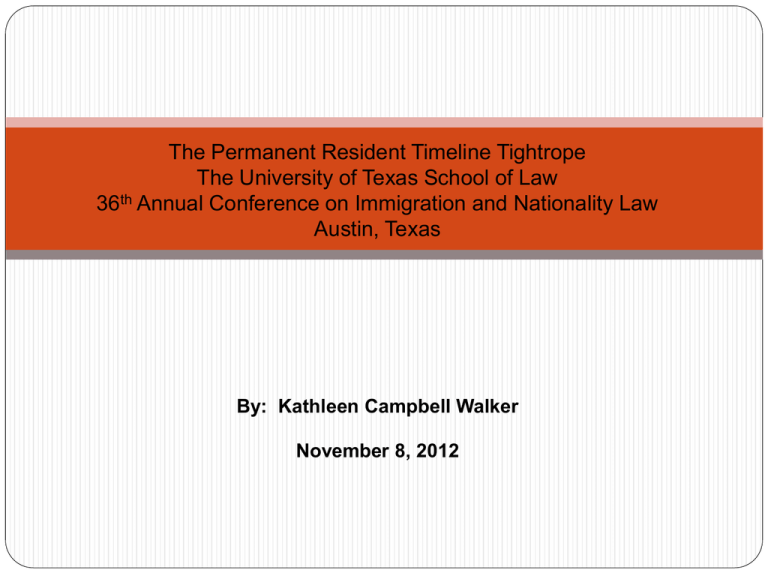
The Permanent Resident Timeline Tightrope The University of Texas School of Law 36th Annual Conference on Immigration and Nationality Law Austin, Texas By: Kathleen Campbell Walker November 8, 2012 THE IMMIGRANT PROCESS Permanent Residence Employment Based Family Based Petition Process Wait for PD Adjustment of Status In the U.S. Consular Process Family Based Preferences First – Unmarried Sons and Daughters of Citizens: 23,400 a year. Second – Spouses and Children, and Unmarried Sons and Daughters of Permanent Residents: 114,200 A. Spouses and Children: 77% of the overall second preference limitation, of which 75% are exempt from the per country limit; B. Unmarried Sons and Daughters (21 years of age or older): 23% of the overall second preference limitation. Third – Married Sons and Daughters of Citizens: 23,400. Fourth – Brothers and Sisters of Adult Citizens: 65,000. Employment Based Preferences First - (EB-1, priority workers); 28.6% of the worldwide employment- based preference level, plus any numbers not required for fourth and fifth preferences. Second - (EB-2, worker with advanced degrees or exceptional ability); 28.6% of the worldwide employment-based preference level, plus any numbers not required by first preference. Third Preference (EB-3, professionals, skilled workers and other workers); 28.6% of the worldwide employment-based preference level, plus any numbers not required by first and second preferences, not more than 10,000 of which to “Other Workers.” Fourth - (EB-4, special workers, such as religious workers); 7.1% of the worldwide level; and Fifth - (EB-5, employment creation or investor visas). 7.1% of the worldwide level, not less than 3,000 of which reserved for investors in a targeted rural or high-unemployment area and 3,000 set aside for investors in regional centers by §610 of Pub. L. No. 102-395 Reading the Visa Bulletin On the charts below, the listing of a date for any class indicates that the class is oversubscribed. “C” means current, i.e., numbers are available for all qualified applicants. “U” means unavailable, i.e., no numbers are available. (NOTE: Numbers are available only for applicants whose priority date is earlier than the cut-off dates listed.) FAMILY BASED WAIT TIMES DEPARTMENT OF STATE –VISA BULLETIN – www.travelstate.gov November 2012 EMPLOYMENT BASED WAIT TIMES DEPARTMENT OF STATE –VISA BULLETIN – www.travel.state.gov November 2012 NFAP Report – EB Wait Times NFAP Report – FB Wait Times Intake Questions 1. 2. 3. 4. 5. 6. 7. 8. 9. 10. Where is the applicant? How did the applicant enter the U.S.? Is the applicant in the U.S. pursuant to an authorized period of admission? Is the applicant a U.S. citizen (USC)? Is the petitioner a USC? Is the applicant already the beneficiary of an immigrant visa petition and/or labor certification? Has the applicant ever been a U.S. legal permanent resident? What happened in any prior application for permanent residence? Is the applicant subject to any grounds of removability or inadmissibility? What is the applicant’s country of chargeability for visa purposes? Is cross-chargeability an option? Has the applicant ever violated the terms of his or her stay in the U.S.? Has the applicant ever been refused admission to the U.S.? Intake Questions – cont’d 11. 12. 13. 14. 15. 16. 17. 18. 19. 20. 21. Review all of the DS-260 and I-485 questions with the applicant in advance. Does the applicant qualify for any waivers? Has the applicant renounced U.S. citizenship? Has the applicant paid required U.S. taxes, if applicable? Has the applicant registered for selective service, if applicable? Does the applicant have any criminal history? Do you have the records of the arrest and the statutory information regarding the alleged crime? Triple check the issue of the application of unlawful presence bars under INA §212(a)(9). Did the applicant ever have A, G, or E nonimmigrant status requiring the filing of an I-508 Waiver of Rights, Privileges and Immunities? Is the applicant subject to the two year foreign residency requirement of INA §212(e)? Is the applicant eligible for a faster path via employment or family based alternatives? See 8 CFR §245.7. Address Potential Conflict Concerns. INA § 245(a) The status of an alien who was inspected and admitted or paroled into the United States (or a VAWA self-petitioner) can be adjusted by the Attorney General if: • (1) the alien makes an application for adjustment, • (2) the alien is eligible to receive an immigrant visa and is admissible to the United States for permanent residence, and • (3) an immigrant visa is immediately available Pardonable Sins and IRs Adjustment – INA § 245(a) and (c) Immediate Relative Defined INA §201(b) – children, spouses, and parents of USCs (parents must be 21) Not applied to IRs under 8 CFR §245.1(b) – work without authorization -- overstay -- not in lawful status -- violated status INA § 245(i) An alien physically present in the United States who entered the United States without inspection can adjust their status if they are the beneficiary of: • (i) a petition for classification under section 204 that was filed with the Attorney General on or before April 30, 2001; or • (ii) an application for labor certification under section 212(a)(5)(A) that was filed pursuant to the regulations of the Secretary of Labor on or before such date Fact Pattern Brenda is a citizen of Brazil who entered the U.S. using a B-1/B-2 visa. During her visit to the U.S. she and her U.S. citizen boyfriend, Peter, decided that they no longer wanted to be apart and they got married. Once married, Peter may file Form I-130 on Brenda’s behalf to request that she be classified as an immediate relative (in this case, wife) of a U.S. citizen. Brenda is eligible for adjustment of status because she is in the U.S. pursuant to inspection and admission and is not subject to any grounds of inadmissibility or deportability. Although Brenda worked without authorization while in the U.S. in B-2 status, working without authorization does not make her ineligible for adjustment of status because she is an immediate relative of a U.S. citizen. Therefore, Brenda may simultaneously file Form I-485, the application to adjust her status to that of a lawful permanent resident. She should become a conditional lawful permanent resident (because she and Peter will have been married less than two years at the time her application for adjustment of status is approved) within 5-6 months, depending on the processing time of the USCIS office with jurisdiction over Peter and Brenda’s residence. The INA §214(b) Poltergeist at Entry Client is a U.S. citizen is a university professor, who wishes to immigrate his Mexican citizen parents to the United States as soon as possible due to the violence in Ciudad Juarez where they have lived for over 50 years. Client has heard that if his parents possess laser visas (i.e., B-1/B-2/BCC), they can apply for admission to the United States using their laser visa for no more than a 30-day visit within a 25-mile perimeter of the border (i.e., Texas not Arizona) and then apply for adjustment of status within the 30 days based on their U.S. citizen son’s I-130 petition. 8 CFR §235.1(h)(1) They ask if there are any risks to this strategy that they heard about recently from a friend, who successfully used it. The INA §214(b) Poltergeist at Entry – Issues INA §214(b)—This section of the INA provides that all applicants for admission to the United States are presumed to be immigrants until they establish to the satisfaction of the consular officer, at the time of application for a visa, and the immigration officers, at the time of application for admission, that he or she is entitled to a nonimmigrant status under INA §101(a)(15). The foreign residence requirement is fairly consistent among nonimmigrant visa categories. The INA, however, has a specific exception to this requirement for H-1B, L-1, and O-1 nonimmigrants. [ INA §214(h) (codifying the concept known as “dual intent”); INA §214(b), (describing immigrant presumption but providing an exception for aliens admissible in the H and L categories); INA §101(a)(15)(O)(i), 8 USC §1101(a)(15)(O)(i) (defining alien of extraordinary ability, but including no requirement that the alien’s stay be temporary)] Expedited Removal—Under INA §235(b)(1)(A)(i), a foreign national who is arriving in the United States and who is determined to be inadmissible under INA §212(a)(6)(C) or §212(a)(7) (except an alien for whom documentary requirements are waived under 8 CFR §211.1(b)(3) or §212.1) shall be ordered removed from the United States. The INA §214(b) Poltergeist at Entry – Issues INA §274(a)—Any person who encourages or induces an alien to come to, enter, or reside in the United States, knowing or in reckless disregard of the fact that such coming to, entry, or residence is or will be in violation of law shall be subject to a fine or imprisonment for 10 years or both for each alien if done for commercial advantage or private financial gain. [INA §274(a)(1)(B)(i). If not done for commercial advantage or private financial gain, then the prison term is five years. ] Overstay and INA §222(g)—INA §222(g)(1) states that if a foreign national is admitted to the United States based on a nonimmigrant visa and then remains in the United States beyond the authorized period of stay, the visa is voided at the conclusion of the period of stay authorized. So, what happens to a laser visa holder with no I-94 on the 31st day? Is there really a period of authorized stay as with a typical I94 documented admission triggering INA §222(g) consequences of visa voidance or is the period of authorized stay in this instance more like a duration of status (D/S) admission granted in F-1 student visa cases? Take a look at the April 1, 1999, letter written by then Acting Assistant Commissioner, Michael J. Hrinyak, indicating that those entering on a laser visa without an I-94, should be treated the same as a D/S admission. The INA §214(b) Poltergeist at Entry – Issues Misrepresentation/Fraud at Entry—An alien who engages in fraud or willful misrepresentation of a material fact in order to procure a visa is inadmissible. [: INA §212(a)(6)(C).] The Department of State (DOS) instructs in the Foreign Affairs Manual that a misrepresentation requires “an affirmative act,” rather than “the failure to volunteer information.” [9 FAM §40.63, N4–4.2. Cf. INA §274C(f), which notes that for determining document fraud penalties, a falsely made document includes one that “fails to state a fact which is material to the purposes for which it was submitted.” Under N4.2, “Silence or the failure to volunteer information does not in itself constitute a misrepresentation for the purposes of INA §212(a)(6)(C)(i).”] To determine whether an alien has made a misrepresentation to obtain a visa, DOS instructs consular officers to apply the “30-/60–day rule.” [9 FAM §40.63, N4.7.] This rule provides that if within 30 days of B-2 visa issuance or entry, the alien: § Actively seeks unauthorized employment and, subsequently, becomes engaged in such employment; § Enrolls in a program of academic study without the benefit of the appropriate change of status; § Marries and takes up permanent residence; or § Undertakes any other activity for which a change of status or an adjustment of status would be required, without the benefit of such a change or adjustment; then the alien is presumed to have misrepresented his or her intent at entry. [ 9 FAM §40.63, N4.72.] After 60 days, DOS does not consider the alien’s activities to constitute the basis for a finding of ineligibility. [ 9 FAM §40.63, N4.7-3.] What to do? Is the attorney subject to potential criminal penalty under INA §274A described above? What if the attorney suggests that the parents enter without an I94 admission and just wait until the 61st day to file for adjustment of status? INA §245(c)(2) provides that for immediate relatives, unlike preference cases for immigrant status, working without authorization or being in unlawful status or violating nonimmigrant status is not a bar to adjustment. How can the attorney explain the decision to file on the 61st or the 90th day? Even with such a filing date, intent at entry as well as the circumstances for admission are still relevant queries. Review Matter of Cavazos, 17 I & N Dec. 215 (1980) From “How toWalk the Ethical Line – Being Less Stressed Out” by Cyrus D. Mehta, Sam Myers, and Kathleen CampbellWalker - presented at AILA Annual Conference 2011 Presenter Kathleen Campbell Walker Shareholder Cox Smith Matthews Incorporated 221 N. Kansas, Suite 2000 El Paso, Texas 79901 Tel: 915-541-9360 Fax: 915-541-9399 kwalker@coxsmith.com



